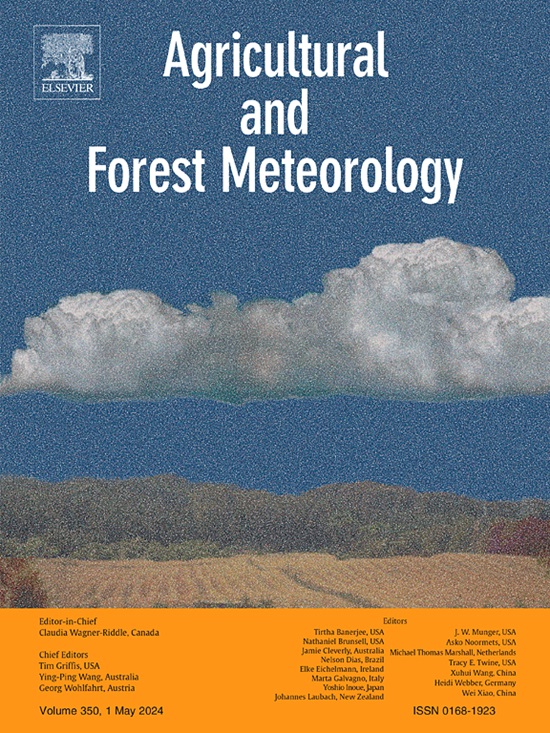Solar-induced chlorophyll fluorescence and its relationship with photosynthesis during waterlogging in a maize field
IF 5.6
1区 农林科学
Q1 AGRONOMY
引用次数: 0
Abstract
Solar-induced chlorophyll fluorescence (SIF) has emerged as a valuable tool for estimating gross primary production (GPP). However, the mechanism linking SIF to GPP under waterlogging stress remains unclear. Here, we investigated the GPP-SIF relationship and their responses to waterlogging stress using three years of continuous ground measurements in a maize field. Our results revealed a significant decoupling in the GPP-SIF relationship under waterlogging stress, as evidenced by a decline in R2 values from 0.87 and 0.79 (non-waterlogging years: 2020 and 2021) to 0.20 (waterlogging year:2022), consistent with SCOPE model simulations. We examined the underlying mechanisms independently regulating SIF and GPP fluctuations. Our analysis suggested a considerable transition in dominating factors influencing both parameters, shifting from photosynthetically active radiation (PAR) under non-waterlogging conditions to soil water content (SWC) under waterlogging stress. Notably, we quantified the impact of elevated SWC on GPP and SIF, finding that the effect was more pronounced on GPP (62.41% reduction) than on SIF (54.3% reduction). We observed the weakened significance of SIF muti-scattering components induced by alterations in soil background spectra due to increased SWC affecting SIF radiative transfer processes. Complemented by SCOPE simulations, our analysis suggested that the significant decoupling of SIF and GPP physiological components, along with asymmetrical responses to SWC, collectively contribute to the reduced GPP-SIF relationship under waterlogging stress. Overall, our study provides valuable insights into GPP and SIF dynamics under waterlogging stress in a maize field, emphasizing the effectiveness of radiative transfer models for understanding plant photosynthetic responses to waterlogging stress.
玉米田涝渍期太阳诱导的叶绿素荧光及其与光合作用的关系
太阳诱导的叶绿素荧光(SIF)已成为估算初级生产总值(GPP)的重要工具。然而,内涝胁迫下SIF与GPP之间的联系机制尚不清楚。在这里,我们通过对玉米田连续三年的地面测量,研究了GPP-SIF关系及其对涝渍胁迫的响应。研究结果显示,涝渍胁迫下GPP-SIF关系存在显著解耦,R2值从0.87和0.79(非涝渍年:2020年和2021年)下降至0.20(涝渍年:2022年),与SCOPE模型模拟结果一致。我们研究了独立调节SIF和GPP波动的潜在机制。我们的分析表明,影响这两个参数的主要因素发生了相当大的转变,从非涝渍条件下的光合有效辐射(PAR)到涝渍胁迫下的土壤含水量(SWC)。值得注意的是,我们量化了SWC升高对GPP和SIF的影响,发现对GPP(降低62.41%)的影响比对SIF(降低54.3%)的影响更为明显。我们观察到,由于SWC增加影响SIF辐射传输过程,土壤背景光谱的变化导致SIF多散射分量的意义减弱。通过SCOPE模拟,我们的分析表明,SIF和GPP生理成分的显著解耦,以及对SWC的不对称响应,共同促成了涝渍胁迫下GPP-SIF关系的降低。总的来说,我们的研究为了解涝渍胁迫下玉米田GPP和SIF的动态提供了有价值的见解,强调了辐射转移模型在理解植物对涝渍胁迫的光合响应方面的有效性。
本文章由计算机程序翻译,如有差异,请以英文原文为准。
求助全文
约1分钟内获得全文
求助全文
来源期刊
CiteScore
10.30
自引率
9.70%
发文量
415
审稿时长
69 days
期刊介绍:
Agricultural and Forest Meteorology is an international journal for the publication of original articles and reviews on the inter-relationship between meteorology, agriculture, forestry, and natural ecosystems. Emphasis is on basic and applied scientific research relevant to practical problems in the field of plant and soil sciences, ecology and biogeochemistry as affected by weather as well as climate variability and change. Theoretical models should be tested against experimental data. Articles must appeal to an international audience. Special issues devoted to single topics are also published.
Typical topics include canopy micrometeorology (e.g. canopy radiation transfer, turbulence near the ground, evapotranspiration, energy balance, fluxes of trace gases), micrometeorological instrumentation (e.g., sensors for trace gases, flux measurement instruments, radiation measurement techniques), aerobiology (e.g. the dispersion of pollen, spores, insects and pesticides), biometeorology (e.g. the effect of weather and climate on plant distribution, crop yield, water-use efficiency, and plant phenology), forest-fire/weather interactions, and feedbacks from vegetation to weather and the climate system.

 求助内容:
求助内容: 应助结果提醒方式:
应助结果提醒方式:


